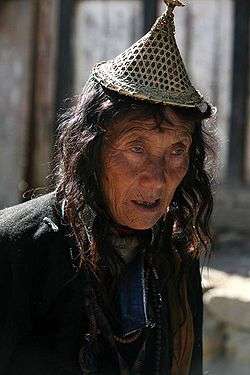Laya dialect
| Laya | |
|---|---|
| ལ་ཡ་ཁ་, layakha | |
|
Layap woman in Laya Gewog | |
| Native to | Bhutan |
| Region | Laya Gewog, Gasa District; northern Punakha District; Lingzhi Gewog, Thimphu District |
| Ethnicity | Layap |
Native speakers | 1,100 (2003)[1] |
| Tibetan | |
| Language codes | |
| ISO 639-3 |
lya |
| Glottolog |
laya1253[2] |
Laya (Dzongkha: ལ་ཡ་ཁ་, ལ་ཡག་ཁ་; Wylie: la-ya-kha, la-yag-kha)[3] is a Tibetic variety spoken by indigenous Layaps inhabiting the high mountains of northwest Bhutan in the village of Laya, Gasa District. Speakers also inhabit the northern regions of Thimphu (Lingzhi Gewog) and Punakha Districts. Its speakers are ethnically related to the Tibetans. Most speakers live at an altitude of 3,850 metres (12,630 ft), just below the Tsendagang peak. Laya speakers are also called Bjop by the Bhutanese, sometimes considered a condescending term. There were 1,100 speakers of Laya in 2003.[4][5]
Laya is a variety of Dzongkha, the national language of Bhutan.[6] There is a limited mutual intelligibility with Dzongkha, mostly in basic vocabulary and grammar.[7]
See also
References
- ↑ Laya at Ethnologue (18th ed., 2015)
- ↑ Hammarström, Harald; Forkel, Robert; Haspelmath, Martin; Bank, Sebastian, eds. (2016). "Layakha". Glottolog 2.7. Jena: Max Planck Institute for the Science of Human History.
- ↑ Dorji, C. T. (1997). An Introduction to Bhutanese Languages. Vikas. p. 25. Retrieved 2011-09-27.
- ↑ Lewis, M. Paul, ed. (2009). Layakha. Ethnologue: Languages of the World (16 (online) ed.). Dallas, Texas: SIL International. Retrieved 2011-09-26.
- ↑ Wangdi, Kencho (2003-11-04). "Laya: Not Quite a Hidden Land". Kuensel online. Archived from the original on 2003-12-07. Retrieved 2011-09-26.
- ↑ van Driem, George; Tshering, Karma (1998). Dzongkha. Languages of the Greater Himalayan Region. 1. Research CNWS, School of Asian, African, and Amerindian Studies. p. 1. ISBN 90-5789-002-X. Retrieved 2011-09-27.
- ↑ "Tribe – Layap". BBC online. 2006-05-01. Retrieved 2011-09-26.
